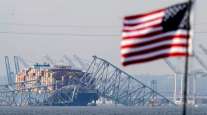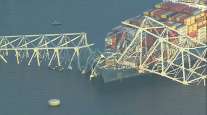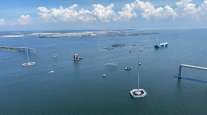Baltimore Sun
New Baltimore Bridge Could Have Higher Clearance
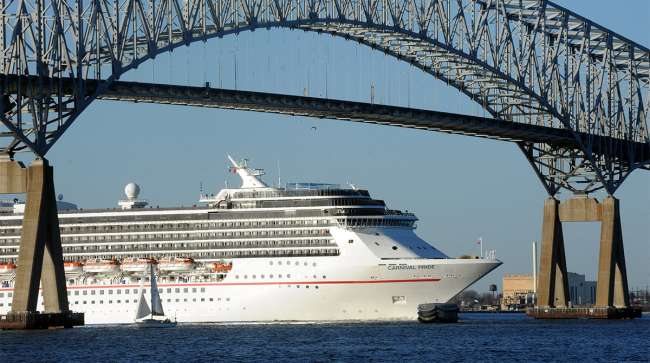
[Stay on top of transportation news: Get TTNews in your inbox.]
BALTIMORE — Baltimore’s corner of the Chesapeake Bay has had a fixed ceiling of sorts — the 185-feet vertical clearance of the area’s bridges — for the past 70 years. Soon, authorities will decide if they want to raise that limit and by how much.
It’s a once-in-a-century opportunity, a decision that will define the vertical limits of the corridor for decades. Determining an optimal height for market and societal needs generations from now requires collaboration from state and federal entities, harbor pilots, and Baltimore Gas and Electric Co. — as well as predicting the size of ships and the rise of sea levels over the decades to come.
The Bay Bridge near Annapolis opened at roughly 185 feet in 1952. When another span was added in 1973 and the Key Bridge constructed in 1977 in Baltimore, each was built to about the same height. To date, that’s been sufficient for the Port of Baltimore’s cargo and cruise industries.
But with an eye to the future, owners of other bridges leading to East Coast ports have raised — or are considering raising — their bridge clearances, despite the high costs of doing so.
Potential builders submitted proposals by a July 1 deadline to replace the Key Bridge, which collapsed March 26 when it was stuck by a containership. The state of Maryland will select a winning team by the end of summer. That means that during the 150-year period from 1952 to well past 2100, this is likely to be the most opportune time to make a permanent change to Baltimore’s “ceiling.”
Busy day yesterday as the Port of Baltimore welcomes back more and more ships!
90 degree temperatures don’t stop our great @ILAUnion from loading and unloading vessels at our Dundalk and Seagirt terminals. @portsamericahq Chesapeake #BaltimoreIsBack #ThePortForOurNation pic.twitter.com/zCc4wcMh2j — Port of Baltimore (@portofbalt) June 21, 2024
Too low and it could jeopardize the port’s future commerce, if shipping lines redirect cargo to rival ports with higher clearances. Too high and it needlessly increases construction costs and potentially makes for more dangerous conditions for vehicle drivers on the bridge deck.
Increasing the shipping channel’s ceiling also means computing its floor: Chesapeake Bay waters are expected to rise between 3 and 5 feet by 2120, according to a federal task force on sea-level rise. That’s higher than the global average.
The new Key Bridge, projected to open in 2028 and cost $1.7 billion, will be built to have a minimum of a 75-year life, although some engineers project it will stand at least 100 years. Meanwhile, the older of the two Bay Bridge spans only has about 15 or 20 years of life left so it, too, will need to be replaced. A new Bay Bridge almost certainly would be made to the same height as the new Key Bridge and that span would, similarly, be built to last more than 75 years.
Vertical clearance — the space between the water and the bottom of a bridge’s roadway — is one of many factors that will be decided as state officials work with a selected Key Bridge builder.
“We’re in the middle of that process right now — looking at the market today, the future market, what’s happening in the industry, and what makes sense for the Port of Baltimore,” Maryland Transportation Secretary Paul Wiedefeld said in an interview in June.
The Key Bridge was knocked down after the cargo ship Dali lost power and smashed into a support pier, killing six road workers and partially blocking the shipping channel for months. The calamity illustrated the importance of planning — or at least trying to — for the future; the bridge wasn’t built with 100,000-ton ships in mind and was ill-prepared for a vessel strike. It prompted a National Transportation Safety Board investigation into what went wrong and a Coast Guard probe into national port infrastructure.
Rebuilding the Key Bridge with the same 185-foot clearance would probably suffice for the immediate future. But as public entities along the East Coast spend millions and billions to stretch out their spans and dredge channels deeper to accommodate larger vessels, planning likely will call for a taller bridge.
Big Ships, Rising Tides
There are few things physically stopping containerships themselves — which doubled, then tripled and now have increased ten-fold in capacity since the 1960s — from growing. In fact, there is an economic incentive for them to get bigger.
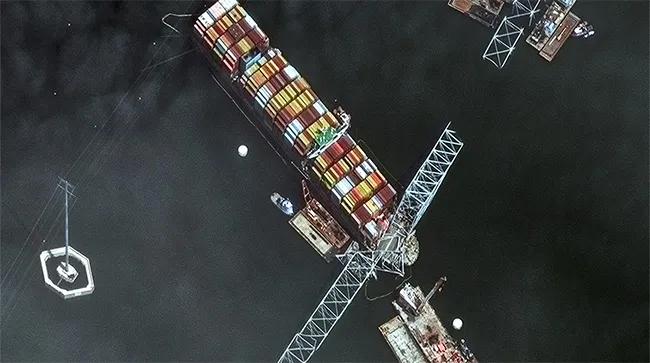
This April 8 satellite image provided by Maxar shows the bow of the containership Dali remained stuck underneath sections of the fallen Francis Scott Key Bridge. (Satellite image ©2024 Maxar Technologies via AP, file)
But external factors could stall their growth. It’s not unlike semitrucks in the U.S. They could be built longer than 53 feet, but external factors (various states’ laws) limit them, said Jean-Paul Rodrigue, a Texas A&M University professor whose research focuses on transportation and logistics.
In the case of cargo ships, it isn’t laws that could restrict their size, but infrastructure. For one thing, there are barriers directly below and above them. Most shipping channels into ports are no deeper than 50 feet, and bridges often set a maximum height.
Capt. Jeffrey Monroe, a master mariner and education director for the International Association of Maritime and Port Executives, said that as ships have grown, “we began to dig deeper.” Baltimore’s channel has been 50 feet deep since the 1970s, but Charleston recently deepened its channel to 52 feet and New York/New Jersey is studying the possibility of dredging to 55 feet.
“Then we began to realize that now our biggest limitation is not the depth of the channel,” said Monroe, who consulted on a project to greatly increase the vertical clearance of the Bayonne Bridge, which connects New Jersey and Staten Island, N.Y. “Our biggest limitation is the infrastructure that flies over the top of it.”
Aside from channel depths and bridges, there are limitations to international shipping. The narrowness of a vital shipping channel near Singapore, the Malacca Strait, as well as the width of the Panama and Suez canals would complicate efforts to make ships larger.
@mpeacock28 showing off the deepest harbor on the East Coast! #chs52 #SCPorts pic.twitter.com/6JWcXAg2JE — South Carolina Ports (@SCPorts) September 26, 2023
But there are already ships built today that can’t fit into the Port of Baltimore. And it’s not just bridge height that limits them. Channel dimensions and the “capacities of a container terminal” also determine the size of a ship that a port can handle, said Richard Scher, spokesperson for the Maryland Port Administration.
“It’s about accommodating the right-sized ship, more than just a big ship,” he said in a statement.
Monroe also noted that logistical concerns mean it would not behoove many East Coast ports to aim to receive ships much larger than they already do. But “never say never,” he added. If it was up to him, he’d make the new Key Bridge 225 feet tall, to give “optimal flexibility.”
But there’s another vertical limitation on a ship’s way into the port: BGE power lines that run parallel to the Key Bridge and have a vertical clearance of 214 feet.
When asked about the potential height of the new bridge, Wiedefeld’s first thought were those cables: “It starts with the BGE line; that’s a certain height,” he said.
Before BGE erected those lines between 2020 and 2022, it received input in 2018 from the port administration “regarding current and potential future clearance requirements for shipping vessels,” BGE spokesperson Stephanie Weaver said in a statement. BGE is in “close communication” with officials regarding the reconstruction of the Key Bridge, she added.
Corey Cox of the Tandet Group of companies discusses how early AI adopters are beginning to harvest the latest wave. Tune in above or by going to RoadSigns.ttnews.com.
Another variable is that, even if the Port of Baltimore never receives any ships taller than the ones it does now, the rising sea adds a challenge.
“That’s a whole ’nother issue to weigh in, as well,” Wiedefeld said of Bay waters rising. “That’s definitely part of the analysis. You have to look at that.”
William Sweet, a National Oceanic and Atmospheric Administration oceanographer, used to live in Annapolis and frequently took a sailboat under the Bay Bridge. Bay waters are just about guaranteed to rise a foot over the next 30 years, Sweet said.
Unless swift changes are made to carbon emissions, they’re expected to rise at a faster rate after that. A century from now, Bay waters are projected to be up at least 3 feet, and could be more than 5 feet higher. It depends on factors well beyond the Chesapeake Bay, including, Sweet noted, if ice sheets in Antarctica “become unhinged.”
“It could be higher,” he said of the Bay waters rising.
Building bridges to last a century requires educated guesswork. For example, decades from now, vehicular traffic patterns could look much different, noted Norma Jean Mattei, a University of New Orleans engineering professor and member of the White House’s National Infrastructure Advisory Council. The Bay waters are no different.
“The world gets fuzzier the further out you go,” she said, “and bridges are one of those pieces of infrastructure that we design for longer life.”
East Coast Bridges Grow
In a way, bridge height is simply a multibillion-dollar-industry version of keeping up with the Joneses. When recently discussing the possibility of replacing a bridge in Savannah, Ga., with a taller one, local officials there referenced the high vertical clearances of bridges leading to New York/New Jersey, a competing port.
The Georgia Department of Transportation is looking to increase the height of that Savannah span, the Talmadge Memorial Bridge, which is 185 feet tall — the same as Maryland’s Bay Bridge.
“As the fastest-growing port in the nation, the Port of Savannah is a significant economic engine for the Savannah region, Georgia, and the rest of the Southeast,” a spokesperson for Georgia’s transportation department said in a statement. “Potentially stifling future growth, however, is the port’s accessibility to larger ships.”
Georgia also is considering replacing the bridge — which opened only 33 years ago — with a span that has 230 feet of vertical clearance.
A neighbor to the north of Baltimore already has changed a bridge’s height. The Port Authority of New York and New Jersey increased the clearance of the Bayonne Bridge from 150 feet to 215 feet — a project that cost $1.7 billion.
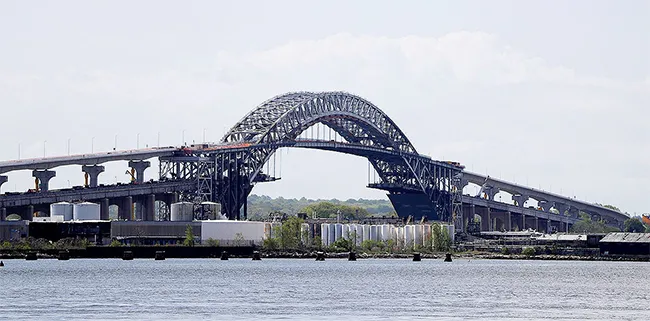
Bayonne Bridge by Julio Cortez/AP
“We raised the Bayonne Bridge in 2019 knowing that containerships were only growing bigger and demand for goods was only getting stronger,” port director Bethan Rooney said in a statement. “It paid off soon after, when the pandemic drove cargo volumes to numbers we weren’t expecting to see for another 10 years.”
Another New York-area bridge has even higher clearance: Big ships can easily fit under the 228 feet afforded by the Verrazano-Narrows Bridge. The 1,200-foot container vessels that call on New York typically have an air draft of about 175 feet to 195 feet, said James Mercante, president of New York’s Board of Commissioners of Pilots.
Cruise ships can come in even higher. The MSC Meraviglia, which sails under the Verrazzano, is 214 feet tall, according to the cruise line.
How tall the new Key Bridge will be remains undetermined, but one potential builder suggested a height of 213 feet in a May news release.
Want more news? Listen to today's daily briefing above or go here for more info
The Association of Maryland Pilots also might have hinted at the measurement its members prefer. The pilots, who guide large ships in Maryland waters, declined to comment for this article. But a representative discussed the possible height of a replacement Bay Bridge during a 2023 meeting of the Baltimore Harbor Safety and Coordination Committee — a joint industry-government advisory panel. Minutes from the meeting said pilots “have recommended a minimum bridge height of 228 ft, but preferably higher.”
Whatever height is chosen would not alter shipping traffic into Baltimore immediately, since the Bay Bridge remains 185 feet tall. Increasing the current Bay Bridge’s height would not be logical or feasible, given its age. But “those bridges are basically coming to end of life, regardless,” said Wiedefeld, the transportation secretary.
The older of the two Bay Bridge spans has about 15 to 20 years left, he said. So, it’s possible that the Chesapeake Bay will see two new bridges in the coming decades; in doing so, the corridor’s ceiling might be altered for the next century.
Distributed by Tribune Content Agency, LLC



